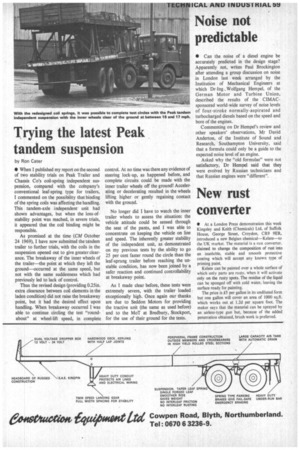Trying the latest Peak tandem suspension
Page 61

If you've noticed an error in this article please click here to report it so we can fix it.
by Ron Cater • When I published my report on the second of two stability trials on Peak Trailer and Chassis Co's coil-spring independent suspension, compared with the company's conventional leaf-spring type for trailers. I commented on the possibility that binding of the spring coils was affecting the handling. This tandem-axle independent unit had shown advantages, but when the loss-ofstability point was reached, in severe trials, it appeared that the coil binding might be responsible.
As promised at the time (CM October 24 1969), I have now submitted the tandem trailer to further trials, with the coils in the suspension opened out to give greater clearance. The breakaway of the inner wheels of the trailer—the point at which they left the ground—occurred at the same speed, but not with the same suddenness which had previously led to lack of control.
Thus the revised design (providing 0.25in. extra clearance between coil elements in the laden condition) did not raise the breakaway point, but it had the desired effect upon handling. When breakaway occurred I was able to continue circling the test "roundabout" at wheel-lift speed, in complete control. At no time was there any evidence of steering lock-up, as happened before, and complete circuits could be made with the inner trailer wheels off the ground! Accelerating or decelerating resulted in the wheels lifting higher or gently regaining contact with the ground.
No longer did I have to watch the inner trailer wheels to assess the situation: the vehicle attitude could be sensed through the seat of the pants, and I was able to concentrate on keeping the vehicle on line and speed. The inherently greater stability of the independent unit, as demonstrated on my previous tests by the ability to go 25 per cent faster round the circle than the leaf-sprung trailer before reaching the unstable condition, has now been joined by a safer reaction and continued controllability at breakaway point.
As I made clear before, these tests were extremely severe, with the trailer loaded exceptionally high. Once again our thanks are due to Seddon Motors for providing the tractive unit (the same as used before) and to the MoT at Bredbury, Stockport, for the use of their ground for the tests.
















































































































































































































